 |
| The Vicarage, Westwood Road, c1883. |
The beautiful old vicarage was demolished in the 1960s, replaced by a more utilitarian building. Its large garden was sold off to developers who built a series of flat roofed flats, some on stilts.
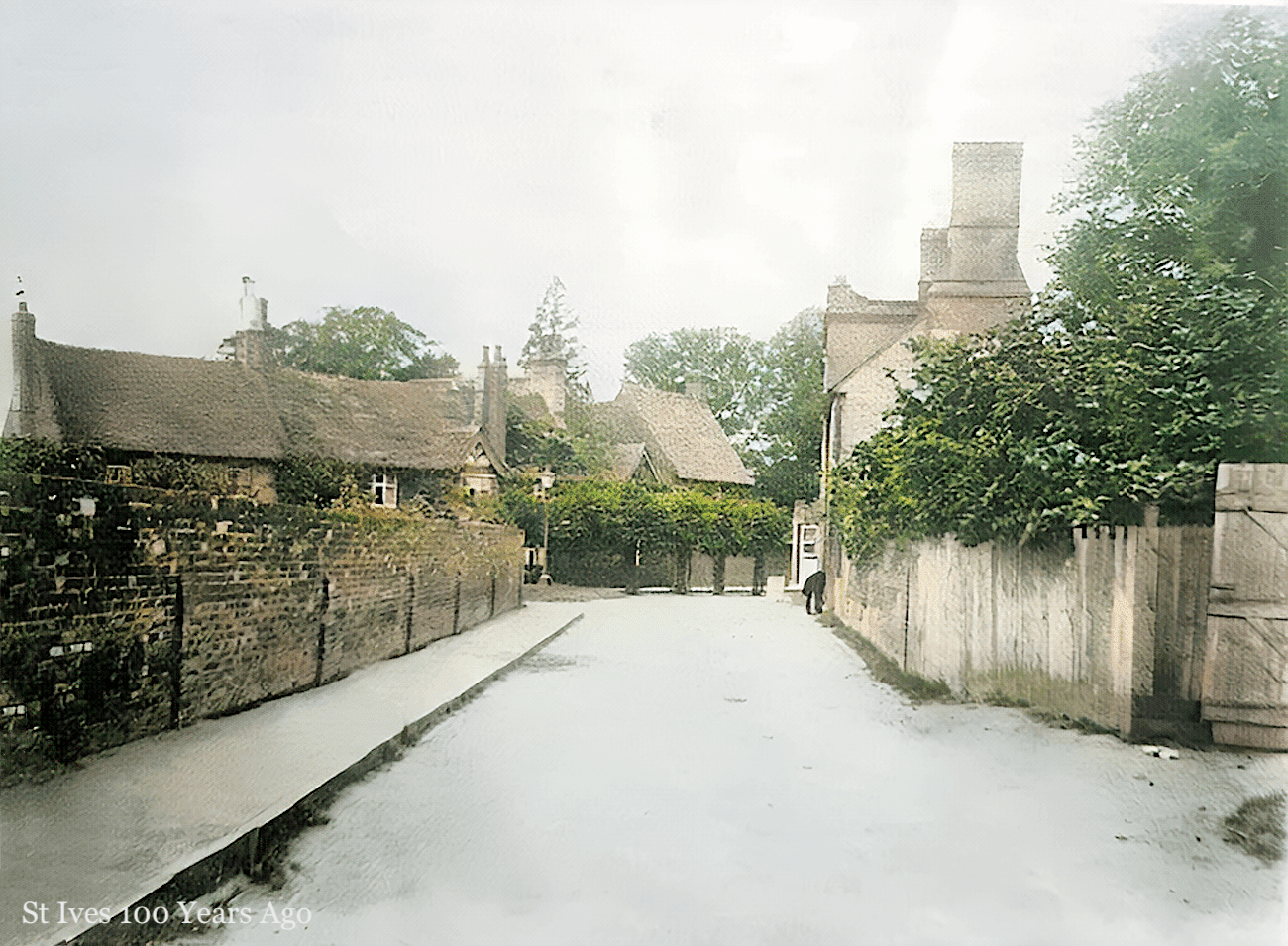 |
| Westwood Road, 1880s. For current view, click here. |
In the above photograph, the large house on the right is believed to be Westwood Farm, formerly West End Farm. From the 1870s this was home to John and Ann Anderson and their thirteen children. The building was knocked down in 1968.
Holt Island
 |
| Employees of John Harrison, basket maker, willow cutting on Holt Island. |
 |
| Workers stripping the willow wands. |
 |
| Barges loaded with bolts of willow. |
The Harrison family started making baskets from willow grown on Holt Island in 1877. Workers cut and bundled willow, loading bolts onto barges for transportation across the river to the inlet located beside today's Dolphin Hotel. Willow wands were made flexible by soaking in long channels that are still visible in the field in front of
Filbert's Walk (see photo under Filbert's Walk), where John Harrison and his brother Charles lived in the late 1800s. They were then woven into baskets for the fruit and potato trade, bicycles, laundry, the post office and fire service.
The Waits
 |
| The Waits, 1890s. |
 |
| Old Methodist Church, The Waits. For current view, click here. |
The original Methodist Church shown above was built in 1815, although St Ives Methodists had been meeting since 1784 in members' houses and a barn. It was replaced in 1905 by the present
carrstone building.
 |
| Organ grinder on The Waits. |
Organ grinders were a common sight at events in the 1800s and early 1900s. This grinder was photographed on The Waits, probably on market day. They're not collecting for charity, as would be the case today. After cranking the organ to collect a few coins they would move to another location to avoid arrest for loitering or being chased by residents who didn't appreciate the same repetitive tune. As often as not they'd be paid to
stop playing.
Grinding the organ and pushing the contraption to its next location was hard work, unheard of for a woman. Look more closely at the adult. Could the person be a heavily made up man dressed in women's clothing, a '
dame' popular in British theatre from the 1800s onwards, the aim being to increase collections?
The Broadway
 |
| The bullock market in The Broadway, early 1880s. |
The above image was taken on a Monday, when the town was taken over by more than 10,000 livestock. Approaches to the town centre would be flooded with cattle, sheep, pigs (hence Pig Lane), horses, chickens, ducks etc. all awaiting sale. The town's population was just 3,000. Dealers came from far and wide to buy for London markets.
The bullock market was held in The Broadway until 1886, when the new cattle market opened at the other end of the town. Many of these cattle were driven for weeks from as far away as Ireland and Scotland. Arriving some time before their sale date, they were fattened up in the water meadows surrounding St Ives. One young resident wrote of falling asleep on Sunday evenings to the sound of cattle lowing in Hemingford Meadow. How were the streets cleaned after market day? Ever resourceful, the Town Council sold the rights to collect cattle droppings. No surprise to learn St Ives has a good collection of
bootscrapers.
The gentleman towards the front left in the black apron is believed to be John Anderson, butcher and town councillor.
 |
| The Broadway early 1900s. For current view, click here. |
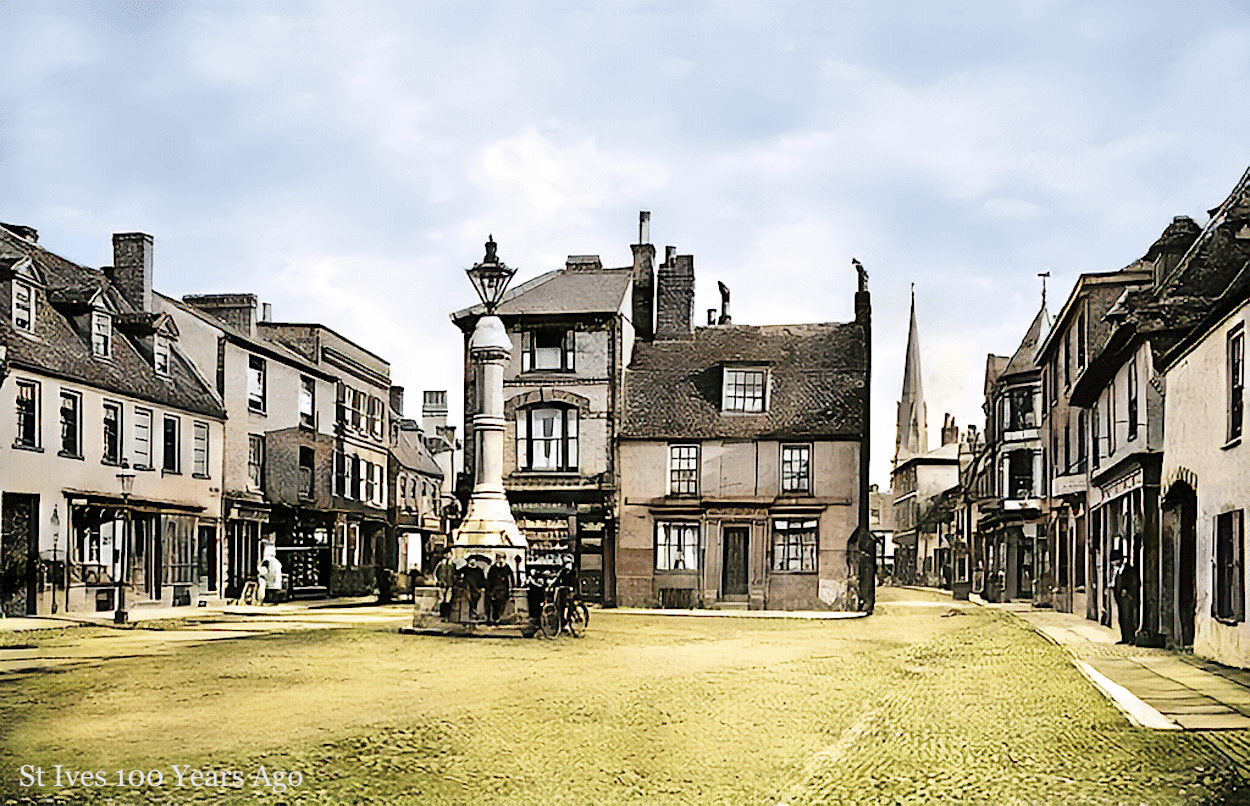 |
| The Broadway early 1900s. For current view, click here. |
 |
| The Victoria Jubilee Monument, The Broadway. For current view, click here. |
At the end of The Broadway is the Victoria Jubilee Monument, unveiled on 30 June 1902. The event it was erected to celebrate, Queen Victoria's diamond jubilee, was actually in 1897.
Elliott Odams, a wine and spirit merchant, took a fancy to a Jubilee Memorial he saw whilst on holiday in the Isle of Wight and decided St Ives deserved an identical monument. Since Elliott was paying, there was little objection locally.
By the time work was completed Queen Victoria had died and a celebration of her jubilee seemed inappropriate. Elliott decided to present the Memorial to St Ives on another day of celebration, the coronation of Victoria's son, Edward VII.
Even then things didn't go smoothly. The inscription on the Memorial already showed an unveiling date of 26 June 1902, being the expected coronation date. When Edward suffered a bout of appendicitis requiring surgery the coronation was postponed. The unveiling finally went ahead on 30 June 1902 and the coronation on 9 August 1902.
 |
| The Broadway looking back towards All Saints Parish Church. |
Merryland
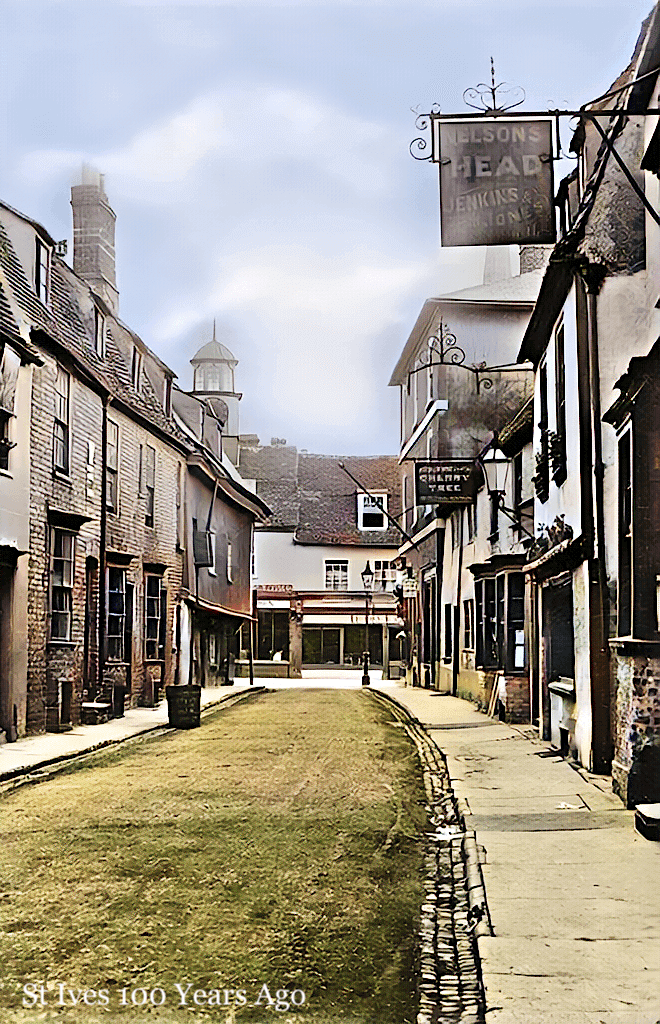 |
| Merryland. |
The Cherry Tree, one of St Ives' lost pubs, is shown halfway down on the left. For more information see
St Ives Photo Album - Pubs and Shops. There's also a good view of the clock tower in Bridge Street. See the Bridge Street section below for more information about the clock tower.
Crown Street
 |
| The Old Courthouse, Crown Street, 1866. For current view, click here. |
Built as early as the 1400s, the Old Courthouse shown above just right of centre included a cellar used as cells. The rooms fronting Crown Street were used for administration, the ground floor latterly a shop. The actual courtroom was a hall behind the building in which, amongst others,
pie powder courts were held. The building was pulled down just after this photograph was taken.
Bridge Street
Fishing in the River Great Ouse was far more popular a century ago. Note the
roach poles leaning against the building on the right. The Kiddle coach family were originally cabinet makers and upholsterers, their shop shown on the right.
 |
| Bridge Street on market day. For current view, click here. |
The basket stall on the right is that of
Charles Bullard, possibly Charles himself posing in the bowler hat. Owner of a successful basket weaving business in St Ives, Charles was also a keen cycler and inventor of the treaded tyre, today a feature of all forms of transport. News of his missed opportunity to become a very wealthy man was syndicated around the world. Just a few years after the above photograph was taken he was declared bankrupt. Charles and his family ended up emigrating to America.
 |
| Bridge Street c1900. For current view, click here. |
 |
| Bridge Street, before 1890. For current view, click here. |
Robert Kiddle's furniture shop in Bridge Street. Note the clock tower, erected in 1802. It was dismantled in 1922 after becoming unsafe. There's an image of the dismantling work in the
St Ives Photo Album - 1920 to 1939.
 |
| Bridge Street, 1898. For current view, click here. |
Note the man in the middle of the street, shovelling horse poo into the back of his cart. Animal droppings were no small problem in St Ives. In addition to daily horse transport, every Monday over 10,000 cattle, sheep, pigs and horses attended the livestock market. The Town Council, ever thrifty, sold the rights to gather droppings in the town centre. They were a valuable commodity for enriching the local allotments and smallholding. Now you know why St Ives has some rather ornate boot scrapers, which can be viewed by
clicking here.
On the left of the above photograph is Wadsworth's cart loaded with boxes of ginger beer, soda water and lemonade bottles. John Wadsworth started his business manufacturing and selling mineral water from The Manor House, 1 Bridge Street, St Ives in 1869. The family firm are still trading today as wine and spirit merchants located in The Broadway.
Edward Collinson, standing in his shop entrance on the right, was a 'fish and ice merchant'. Edward was originally from Grimsby, home to the world's largest fishing fleet. Moving his wife and seven children to St Ives before 1900, he took advantage of rail transport to supply fresh fish from his home town to the residents of St Ives.
 |
| Celebrating the first Empire Day, Bridge Street, 1902. For current view, click here. |
St Ives bridge
At the time of this photograph what is now the chapel on the bridge was occupied as a private residence. The top storey was removed and the building restored to a chapel in 1930. To learn more about the bridge and chapel,
click here.
 |
| The White Horse Hotel, just over St Ives Bridge, pre 1910. For current view, click here. |
The earliest record of The White horse is from a reported murder in 1663. It continued to operate as licensed premises with accommodation until 1914. At the start of WWI the military authorities took it over to billet soldiers sent to St Ives for training. The White Horse never reopenend after the war and was used as private accommodation thereafter.
St Ivians await the next ice-skating race. The course started just beyond the bridge at Hemingford Meadow, swept under the bridge and ran down to the Staunch. Some eager casual skaters made it all the way to St Neots.
























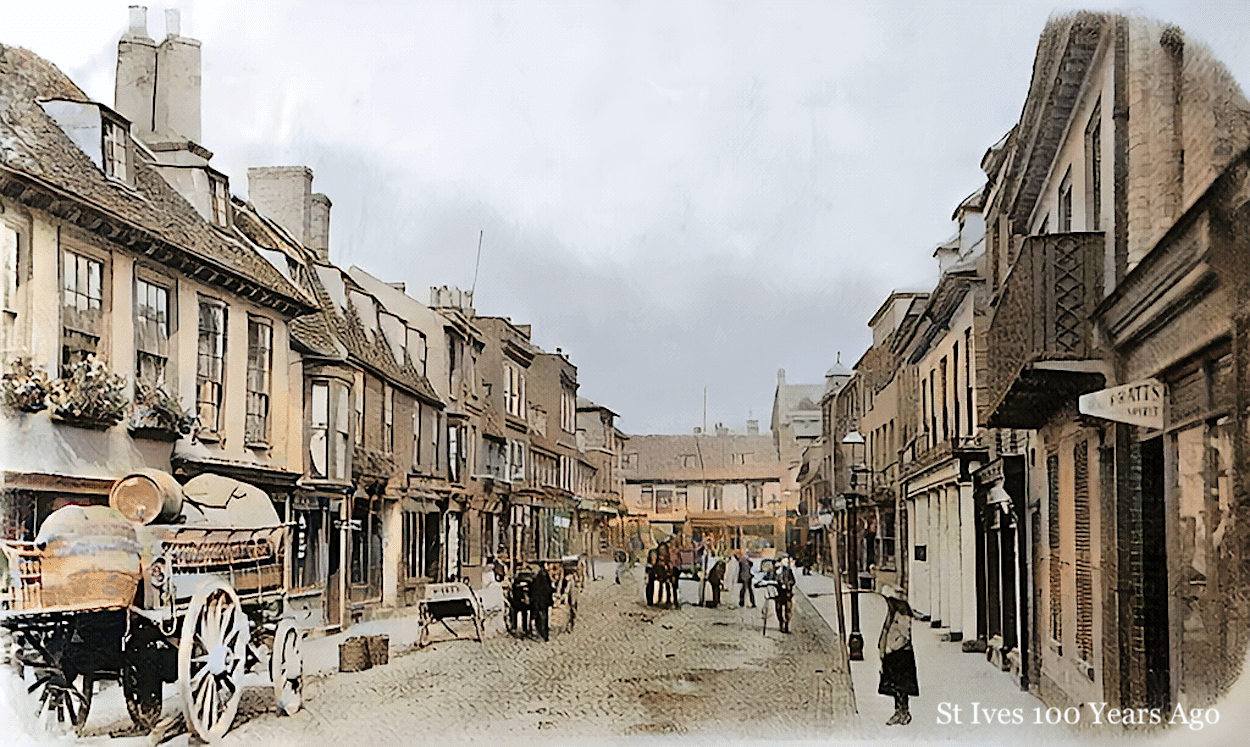









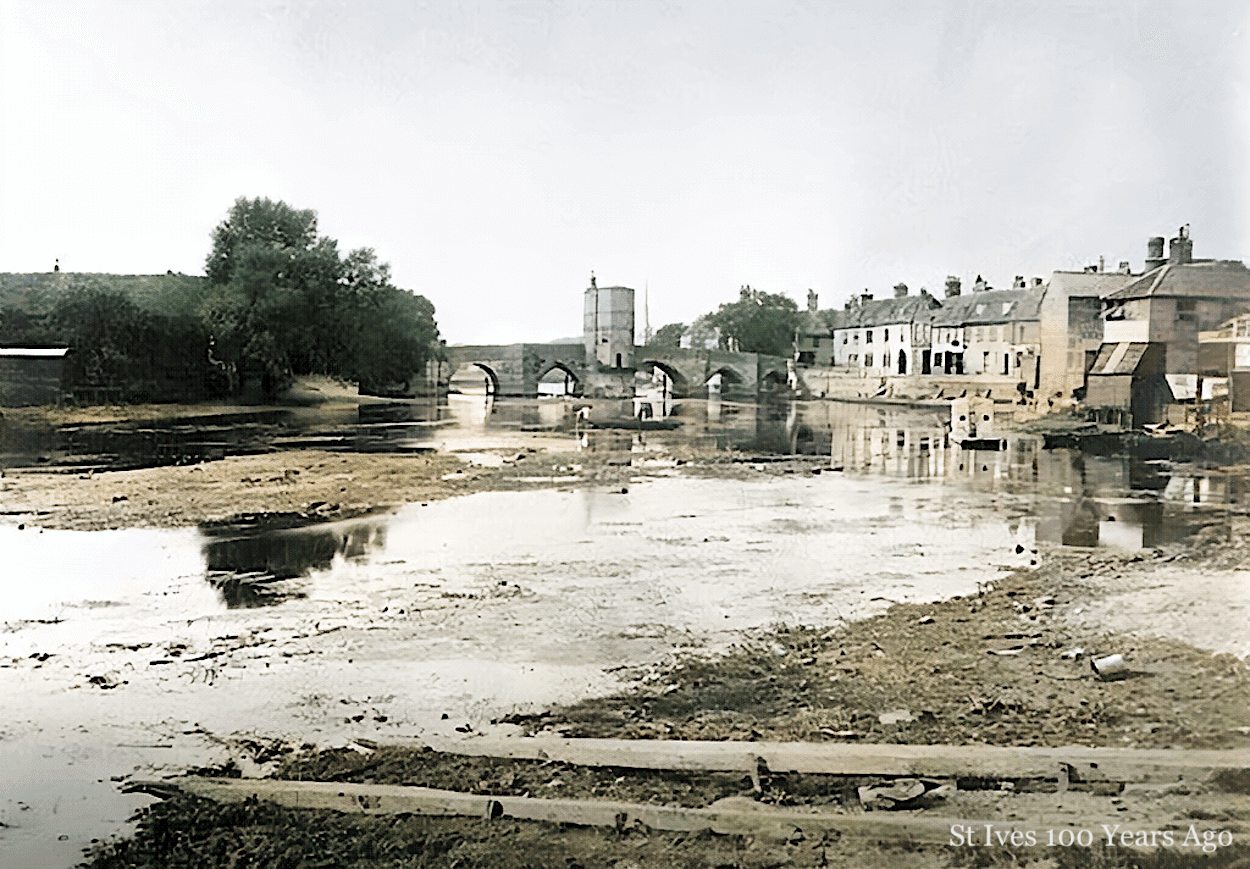



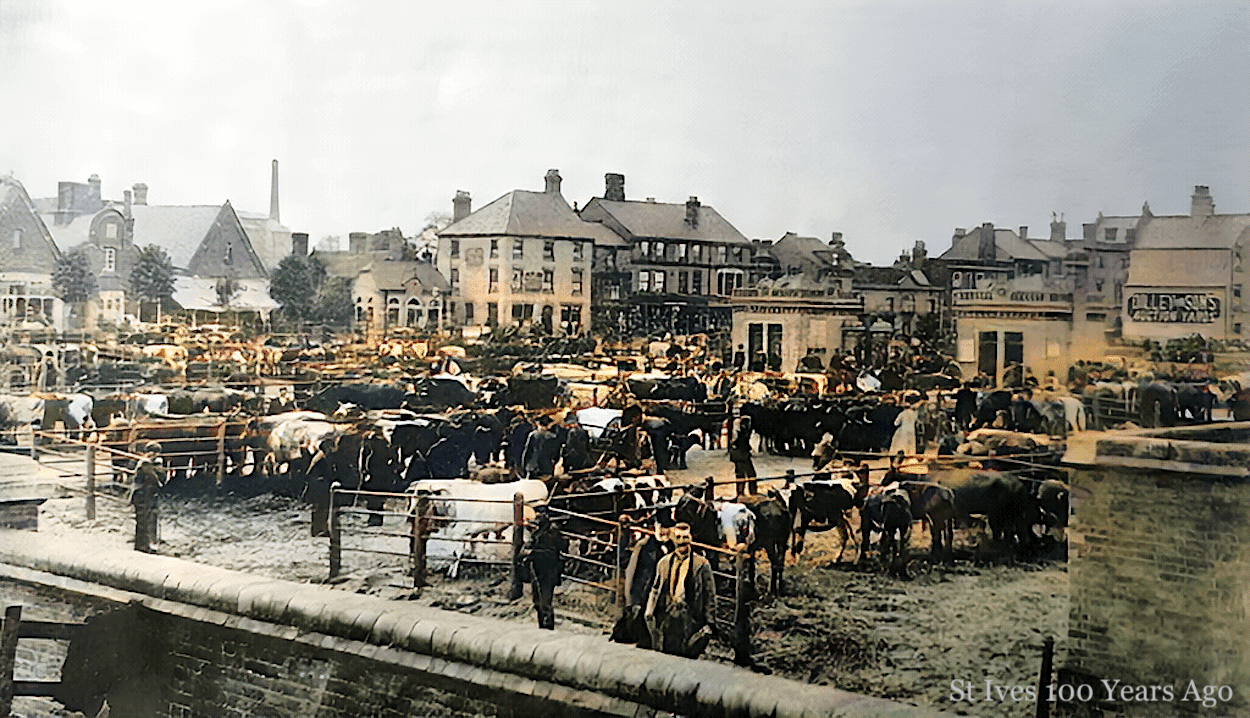
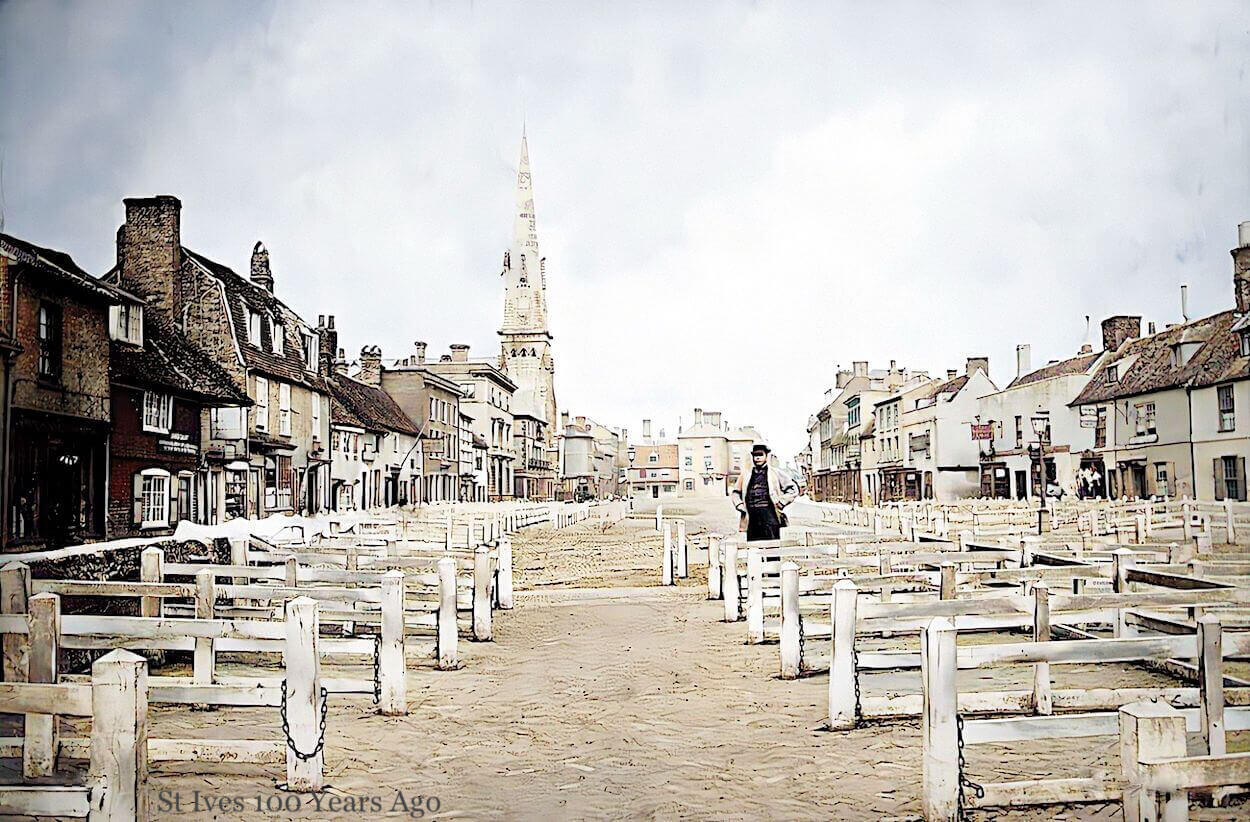





















The picture you have of John Harrison's workers on Holt Island, is rather strange, as in Over, where I live, this picture is taken at Sycamore Farm, New Road in Over! The owner of Sycamore Farm, Alfred Watts, had the osier beds at Overcote and towards the Staunch, as did his father before him. Could you please confirm if there is anything on your picture stating where it was taken?
ReplyDeleteHi Carolyn... Thanks for getting in touch. The image comes from a group of 4 on Facebook site 'St Ives Cambridgeshire..Serious discussions and posts' in 2020, with the text below. If you go onto that site (https://www.facebook.com/share/ZDhGFms21nWK7RG1/) and search 'John Harrison' you'll see the post amongst others. Three of the images are certainly about the Harrisons of St Ives, so I assumed the image you question was part of the same group. If you could confirm your suspicions, I'll take the image down. Thanks, John
Delete'Hi, i am researching basketry in the local area and have made some discoveries including Harrison and Co and Charles Bullard. I am particularly interested in basket styles and any that might be particular to the area. Does anyone have a Harrisons basket or know where I could view one or have anything interesting that would aid my research please?'